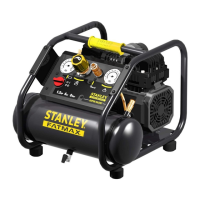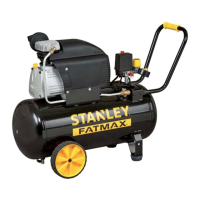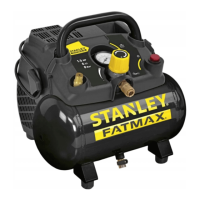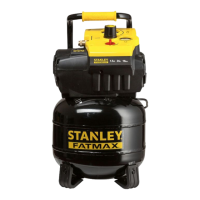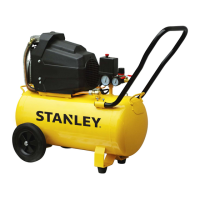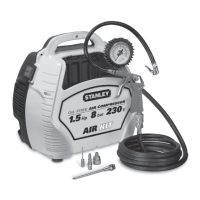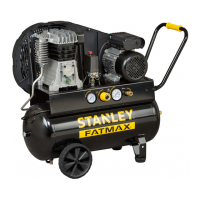4 5
SAFETY GUIDELINES /
DEFINITIONS
DANGER: Indicates an imminently hazardous situation which, if not avoided,
will result in death or serious injury.
WARNING: Indicates a potentially hazardous situation which, if not avoided,
may result in death or serious injury.
CAUTION: Indicates a potentially hazardous situation which, if not avoided,
may result in minor or moderate injury.
Used without the word, indicates a safety related message.
NOTICE: Indicates a practice not related to personal injury which, if not
avoided, may result in property damage.
RISK OF UNSAFE OPERATION. When using tools or equipment, basic
safety precautions should always be followed to reduce the risk of personal injury.
Improper operation, maintenance or modification of tools or equipment could
result in serious injury and property damage. There are certain applications for
which tools and equipment are designed. Manufacturer strongly recommends that
this product NOT be modified and/or used for any application other than for which
it was designed. Read and understand all warnings and operating instructions
before using any tool or equipment.
READ ALL
INSTRUCTIONS
WARNING: Read and understand this instruction manual before using
this unit.
IMPORTANT SAFETY
INSTRUCTIONS
WARNING: FAILURE TO FOLLOW THE FOLLOWING WARNINGS AND
INSTRUCTIONS MAY RESULT IN ELECTRIC SHOCK, FIRE AND/OR SERIOUS
INJURY.
GENERAL SAFETY WARNINGS AND INSTRUCTIONS
• This unit was designed for household use only.
• Avoid dangerous environments. Don’t use appliances in damp or wet locations.
Don’t use appliances in the rain.
• Keep children away. All visitors should be kept at a distance from work area.
• Dress properly. Do not wear loose clothing or jewelry. They can be caught in
moving parts. Rubber gloves and substantial, non-skid footwear are recommended
when working outdoors. Wear protective hair covering to contain long hair.
• Store idle appliance indoors. When not in use, appliances should be stored
indoors in dry, and high or locked-up place – out of reach of children.
• Don’t abuse cord. Never carry appliance by cord or yank it to disconnect from
receptacle. Keep cord from heat, oil, and sharp edges.
• Disconnect appliances. Disconnect the appliance from the power supply when
not in use, before servicing, and when changing accessories.
• Ground Fault Circuit Interrupter (GFCI) protection should be provided on
the circuits or outlets to be used. Receptacles are available having built in GFCI
protection and may be used for this measure of safety.
• Use of accessories and attachments. The use of any accessory or attachment
not recommended for use with this appliance could be hazardous. Refer to the
accessory section of this manual for further details.
• Stay alert. Use common sense. Do not operate this equipment when you are
tired or impaired.
• Check for damaged parts. Any part that is damaged should be replaced by the
manufacturer before further use. Do not use tool if switch does not turn it on and
off. Contact the manufacturer at 1-877-571-2391 for more information.
• Do not operate this appliance near flammable liquids or in gaseous or
explosive atmospheres. Motors in these tools normally spark, and the sparks
might ignite fumes.
• Never submerge this unit in water; do not expose it to rain, snow or use
when wet.
• To reduce risk of electric shock, disconnect the unit from any power source
before attempting maintenance or cleaning. Turning off controls without
disconnecting will not reduce this risk.
• This equipment employs parts (switches, relays, etc.) that produce arcs or
sparks. Therefore, if used in a garage or enclosed area, the unit MUST be placed
not less than 18 inches above the floor.
SPECIFIC SAFETY INSTRUCTIONS FOR CHARGING THIS UNIT
• IMPORTANT: This unit is delivered in a partially charged state. Fully charge unit
with the supplied 120 volt AC charger for a full 24 hours before using for the
first time.
• To recharge this unit, use only the supplied charging adapters. Plug in the
charging adapter at the jump starter first, then plug into the charging source.
• After charging/recharging, disconnect charging adapter and wait 5 minutes
before use.
• Do not crush, cut, pull or expose charging adapter cords to extreme heat.
• Pull by plug rather than cord when unplugging the charger.
• Position charging adapter cords so they do not become entangled or become a
safety hazard. Keep charging adapter cords away from sharp edges.
• Charge in a dry location only.
• All ON/OFF switches should be in the OFF position when the unit is charging or
not in use. Make sure all switches are in the OFF position before connection to a
power source or load.
• Do not attempt to charge the unit if the charger is damaged – return the charger
to manufacturer for repair or replacement.
Extension Cords
• Outdoor use extension cords. When appliance is charged outdoors, use only
extension cords intended for use outdoors and so marked.
• Make sure your extension cord is in good condition. When using an
extension cord, be sure to use one heavy enough to carry the current your product
will draw. An undersized cord will cause a drop in line voltage resulting in loss
of power and overheating. The following table shows the correct size to use
depending on cord length and nameplate ampere rating. If in doubt, use the next
heavier gauge. The smaller the gauge number, the heavier the cord.
MINIMUM GAUGE FOR CORD SETS
Volts Total Length of Cord in Feet
120V 0-25 26-50 51-100 101-150
(0-7.6m) (7.6-15.2m) (15.2-30.4m) (30.4-45.7m)
240V 0-50 51-100 101-200 201-300
(0-15.2m) (15.2-30.4m) (30.4-60.9m) (60.9-91.4m)
Ampere Rating Extension Cord Length
More Not more
0’-25’ 26’-50’ 51’-100’ 101’ -150’
Than Than American Wire Gauge (AWG)
0 - 6 18 16 16 14
6 - 10 18 16 14 12
10 - 12 16 16 14 12
12 - 16 14 12 Not Recommended
When an extension cord is used, make sure that:
– the pins of extension cord are the same number, size and shape as those in
the charger,
– the extension cord is properly wired and in good electrical condition,
– the wire size is large enough for the AC rating of the charger.
CAUTION – TO REDUCE THE RISK OF INJURY OR PROPERTY DAMAGE:
Pull the extension cord by the plug rather than the cord when disconnecting from
the built-in 120 volt AC charger or the AC outlet.
SPECIFIC SAFETY INSTRUCTIONS FOR JUMP STARTERS
WARNING: BURST HAZARD
Do not use the unit for charging dry-cell batteries that are commonly used with
home appliances. These batteries may burst and cause injury to persons and
damage property. Use the unit for charging/boosting a lead-acid battery only. It is
not intended to supply power to a low-voltage electrical system other than in a
starter-motor application.
• Use of an attachment not supplied, recommended or sold by manufacturer
specifically for use with this unit may result in a risk of electrical shock and injury
to persons.
WARNING: RISK OF EXPLOSIVE GASES
• Working in the vicinity of a lead acid battery is dangerous. Batteries generate
explosive gases during normal battery operation. For this reason, it is of the
utmost importance that each time before using the jump-starter you read this
manual and follow instructions exactly.
• To reduce the risk of battery explosion, follow these instructions and those
published by the battery manufacturer and manufacturer of any equipment you
intend to use in the vicinity of the battery. Review cautionary markings on these
products and on the engine.
CAUTION – TO REDUCE THE RISK OF INJURY OR PROPERTY DAMAGE:
• NEVER ATTEMPT TO JUMP-START OR CHARGE A FROZEN BATTERY.
• Vehicles that have on-board computerized systems may be damaged if vehicle
battery is jump-started. Before jump-starting, read the vehicle’s owner’s manual to
confirm that external-starting assistance is suitable.
• Never smoke or allow a spark or flame in vicinity of vehicle battery, engine or
power station
• Remove personal metal items such as rings, bracelets, necklaces and watches when
working with a lead acid battery. A lead acid battery can produce a short circuit
current high enough to weld a ring, or similar metal object, to skin, causing a
severe burn.
• Do not wear vinyl clothing when jump-starting a vehicle when jump-starting a
vehicle, friction can cause dangerous static-electrical sparks.
• Jump-start procedures should only be performed in a safe, dry, well-ventilated area.
• Always store battery clamps when not in use. Never touch battery clamps together.
This can cause dangerous sparks, power arcing and/or explosion.
• When using this unit close to the vehicle’s battery and engine, stand the unit on a
flat, stable surface, and be sure to keep all clamps, cords, clothing and body parts
away from moving vehicle parts.
• Never allow red and black clamps to touch each other or another common metal
conductor — this could cause damage to the unit and/or create a sparking/
explosion hazard.
• If the connections to the battery’s positive and negative terminals are incorrect,
the Reverse Polarity Indicator will light (red) and the unit will sound a continuous
alarm until the clamps are disconnected. Disconnect clamps and reconnect to
battery with correct polarity.
• Always disconnect the negative (black) jumper cable first, followed by the positive
(red) jumper cable, except for positive grounded systems.
• Do not expose battery to fire or intense heat since it may explode. Before
disposing of the battery, protect exposed terminals with heavy-duty electrical tape
to prevent shorting (shorting can result in injury or fire).
• Place this unit as far away from the battery as cables permit.
• Never allow battery acid to come in contact with this unit.
• Do not operate this unit in a closed area or restrict ventilation in any way.
• This system is designed to be used only on vehicles with a 12 volt DC battery
system. Do not connect to a 6 volt or 24 volt battery system.
• This system is not designed to be used as a replacement for a vehicular battery. Do
not attempt to operate a vehicle that does not have a battery installed.
• Excessive engine cranking can damage a vehicle’s starter motor. If the engine
fails to start after the recommended number of attempts, discontinue jump-start
procedures and look for other problems that may need to be corrected.
• Do not use this jump-starter on a watercraft. It is not qualified for marine applications.
• Although this unit contains a non-spillable battery, it is recommended that unit be
kept upright during storage, use and recharging. To avoid possible damage that
may shorten the unit’s working life, protect it from direct sunlight, direct heat and/
or moisture.
SPECIFIC SAFETY INSTRUCTIONS FOR COMPRESSORS
WARNING – BURSTING ARTICLES CAN CAUSE SERIOUS INJURY:
• Carefully follow instructions on articles to be inflated.
• Never exceed recommended pressures. If no pressure is given, contact article
manufacturer before inflating.
• Monitor the pressure at all times on the pressure gauge.
CAUTION – TO REDUCE THE RISK OF PROPERTY DAMAGE:
Do not operate compressor continuously for longer than approximately 10 minutes,
depending on ambient temperatures, as it may overheat. In such event, compressor
may automatically shut down. Turn off the Compressor Power Switch immediately
and restart after a cooling down period of approximately 30 minutes.
CAUTION – TO REDUCE THE RISK OF INJURY OR PROPERTY DAMAGE:
Never leave the compressor unattended while in use.
SPECIFIC SAFETY INSTRUCTIONS FOR THE USB CHARGING/
POWER PORTS
• Do not insert foreign objects into the USB Ports.
• Do not attach USB hubs or more than one personal electronic device to each USB
Port.
• Do not use this unit to operate appliances that require more than 3.1A (5V) to
operate from each of the USB Ports.
• Some household USB-powered electronics will not operate with this unit.
FIRST AID
When working with lead acid batteries, always make sure immediate assistance is
available in case of accident or emergency.
Always have protective eyewear when using this product: contact with battery acid
may cause blindness and/or severe burns. Be aware of first aid procedures in case of
accidental contact with battery acid.
Have plenty of fresh water and soap nearby in case battery acid contacts skin.
• Skin: If battery acid contacts skin or clothing, wash immediately with soap and
water for at least 10 minutes. If redness, pain, or irritation occurs, seek immediate
medical attention.
• Eyes: If battery acid comes in contact with eyes, flush eyes immediately, for a
minimum of 15 minutes and seek immediate medical attention.
SAVE THESE
INSTRUCTIONS
INTRODUCTION
Congratulations on purchasing your new Stanley
®
Fatmax
®
350A Jump Starter
with Compressor. Read this Instruction Manual and follow the instructions
carefully before using this unit.
CHARGING/RECHARGING
Lead-acid batteries require routine maintenance to ensure a full charge and long
battery life. All batteries lose energy from self-discharge over time and more
rapidly at higher temperatures. Therefore, batteries need periodic charging to
replace energy lost through self-discharge. When the unit is not in frequent use,
manufacturer recommends the battery be recharged at least every 30 days.
IMPORTANT: If you know the unit is discharged, but the Battery Status LEDs
illuminate as if the unit is fully charged when connected to a charging power
source, this may be due to the internal battery having high impedance. The
manufacturer suggests leaving the unit charging for a period of 24-36 hours using
the supplied AC charger before use.
Notes: This unit is delivered in a partially charged state – you must fully charge it upon purchase and before
using it for the first time. Initial AC charge should be for 24 hours.
Recharging battery after each use will prolong battery life; frequent heavy discharges between
recharges and/or overcharging will reduce battery life. The battery can be recharged using the
supplied 120 Volt AC Charger.
Make sure all other unit functions are turned off during recharging, as this can slow the recharging
process.
NOTICE: Failure to keep the battery charged will cause permanent damage and
result in poor jump starting performance.
Charging/recharging using the 120V AC charging
adapter
• Make sure all of the unit’s functions are turned off.
• Insert the barrel connector of the AC Charging Adapter into the 12V DC Charging
Port on the back of the unit. Insert the plug end into a (powered) standard North
American 120 volt 60Hz outlet.
• Once the green LED lights or flashes, continue to charge for approximately 1-2
hours. Charge until two red and one green LED Battery Status Indicators light
solid.
• Disconnect the AC Charging Adapter and depress the Battery Power Level Button.
If all 3 status lights illuminate, the unit is fully charged.
JUMP-STARTER
This Jump-Starter is equipped with an On/Off Power Switch. Once the connections
are properly made, turn the switch on to jump-start
the vehicle.
1. Turn off vehicle ignition and all accessories (radio, A/C, lights, connected cell
phone chargers, etc.). Place vehicle in “park” and set the emergency brake.
2. Make sure the Jump-Starter Power Switch is turned to off.
3. Remove jumper clamps from clamp tabs. Connect the red clamp first, then the
black clamp.
J7CS_J7CSC_ManualENSP_072321.indd 4-5J7CS_J7CSC_ManualENSP_072321.indd 4-5 7/26/2021 10:35:04 AM7/26/2021 10:35:04 AM
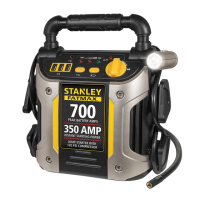
